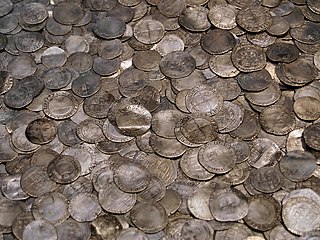
The Ziwiye hoard is a treasure hoard containing gold, silver, and ivory objects, also including a few Luristan pieces, that was uncovered on the south shore of Lake Urmia in Ziwiyeh, Kurdistan Province, Iran, in 1947.

The Hoxne Hoard is the largest hoard of late Roman silver and gold discovered in Britain, and the largest collection of gold and silver coins of the fourth and fifth centuries found anywhere within the Roman Empire. It was found by Eric Lawes, a metal detectorist in the village of Hoxne in Suffolk, England in 1992. The hoard consists of 14,865 Roman gold, silver, and bronze coins and approximately 200 items of silver tableware and gold jewellery. The objects are now in the British Museum in London, where the most important pieces and a selection of the rest are on permanent display. In 1993, the Treasure Valuation Committee valued the hoard at £1.75 million.

The Środa Treasure is a hoard of silver and gold coins, plus gold jewellery and some precious stones. The hoard dates from the mid 14th century. Its largest component is silver coins, of which there are about 3,000 pieces. The hoard was found in years 1985–1988 during renovation works in Silesian town of Środa Śląska, Poland. Today it is mostly kept in the Regional Museum in Środa Śląska.
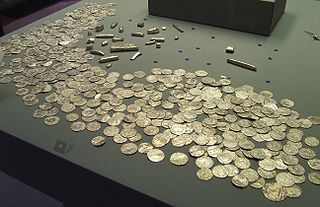
The Vale of York Hoard, also known as the Harrogate Hoard and the Vale of York Viking Hoard, is a 10th-century Viking hoard of 617 silver coins and 65 other items. It was found undisturbed in 2007 near the town of Harrogate in North Yorkshire, England. The hoard was the largest Viking one discovered in Britain since 1840, when the Cuerdale hoard was found in Lancashire, though the Anglo-Saxon Staffordshire Hoard, found in 2009, is larger.

The Staffordshire Hoard is the largest hoard of Anglo-Saxon gold and silver metalwork yet found. It consists of over 3,500 items, amounting to a total of 5.1 kg (11 lb) of gold, 1.4 kg (3 lb) of silver and some 3,500 pieces of garnet cloisonné jewellery.
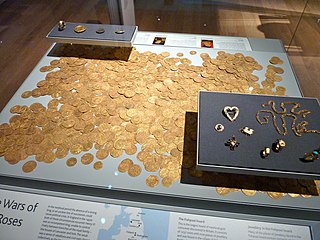
In 1966 the Fishpool Hoard of 1,237 15th century gold coins, four rings and four other pieces of jewellery, and two lengths of gold chain was discovered by workmen on a building site near present-day Cambourne Gardens, in Ravenshead, Nottinghamshire, England, an area that was then known as "Fishpool". It is the largest hoard of medieval coins ever found in Britain. To judge from the dates of the coins, the hoard was probably buried in haste at some time between winter 1463 and summer 1464, perhaps by someone fleeing south after the Battle of Hexham in May 1464, in the first stages of England's civil war between aristocratic factions, the War of the Roses. The Fishpool Hoard, on display in Room 40 in the British Museum, London, was listed in 2003 among Our Top Ten Treasures, a special episode of BBC Television series Meet the Ancestors that profiled the ten most important treasures ever unearthed in Britain as voted by a panel of experts from the British Museum. The British Museum assesses the face value of the hoard when deposited, about £400, would be equivalent to around £300,000 today.

The Canterbury-St Martin's hoard is a coin-hoard found in the 19th century at Canterbury, Kent dating from the 6th century. The group in the World Museum, Liverpool consists of eight items, including three gold coins mounted with suspension loops for use as pendants. One of these is the Liudhard medalet, the earliest surviving Anglo-Saxon coin. Another coin is in the Bibliotheque Nationale.

The Winchester Hoard is a hoard of Iron Age gold found in a field in the Winchester area of Hampshire, England, in 2000, by a retired florist and amateur metal detectorist, Kevan Halls. It was declared treasure and valued at £350,000—the highest reward granted under the Treasure Act 1996 up to the time.

The Ribchester Helmet is a Roman bronze ceremonial helmet dating to between the late 1st and early 2nd centuries AD, which is now on display at the British Museum. It was found in Ribchester, Lancashire, England in 1796, as part of the Ribchester Hoard. The model of a sphinx that was believed to attach to the helmet was lost.
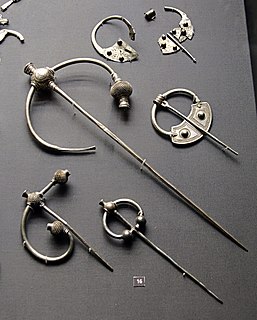
The Penrith Hoard is a dispersed hoard of 10th century silver penannular brooches found at Flusco Pike, Newbiggin Moor, Near Penrith in Cumbria, and now in the British Museum in London. The largest "thistle brooch" was discovered in 1785 and another in 1830, with the bulk of items being recovered in two groups close to each other by archaeologists in 1989. Whether all the finds made close to each other were originally deposited at the same time remains uncertain, but it is thought likely that at least the brooches were. The brooches are thought to have been deposited in about 930.
The Galloway Hoard is a hoard of more than 100 gold and silver objects from the Viking age discovered in the historical county of Kirkcudbrightshire in Dumfries and Galloway in Scotland in September 2014. Found on Church of Scotland land, the hoard has been described by experts as "one of the most significant Viking hoards ever found in Scotland". It was discovered by a metal detector enthusiast who reported the find to the authorities. A county archaeologist carried out an excavation which unearthed a rich and unusually varied collection of jewellery from the Viking world, Anglo-Saxon England and elsewhere in Europe. It is thought that the hoard was buried some time in the mid-ninth or tenth century, though it is not known why it was buried. It was valued in 2017 by an advisory panel to the Queen’s and Lord Treasurer's Remembrancer (QLTR) at £2 million. Scottish law allows the finder to keep the full value of treasure without an owner. The National Museum of Scotland raised the funds to give the hoard a permanent home in Scotland.

The Bedale Hoard is a hoard of forty-eight silver and gold items dating from the late 9th to early 10th century AD and includes necklaces, arm-bands, a sword pommel, hacksilver and ingots. It was discovered on 22 May 2012 in a field near Bedale, North Yorkshire by metal detectorists, and reported via the Portable Antiquities Scheme. Following a successful public funding campaign, the hoard was acquired by the Yorkshire Museum for £50,000.
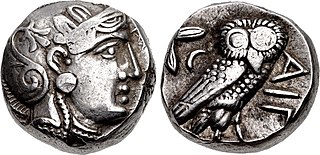
The Kabul hoard, also called the Chaman Hazouri, Chaman Hazouri or Tchamani-i Hazouri hoard, is a coin hoard discovered in the vicinity of Kabul, Afghanistan. The hoard, discovered in 1933, contained numerous Achaemenid coins as well as many Greek coins from the 5th and 4th centuries BCE. Approximately one thousand coins were counted in the hoard. The deposit of the hoard is dated to approximately 380 BCE, as this is the probable date of the least ancient datable coin found in the hoard.
